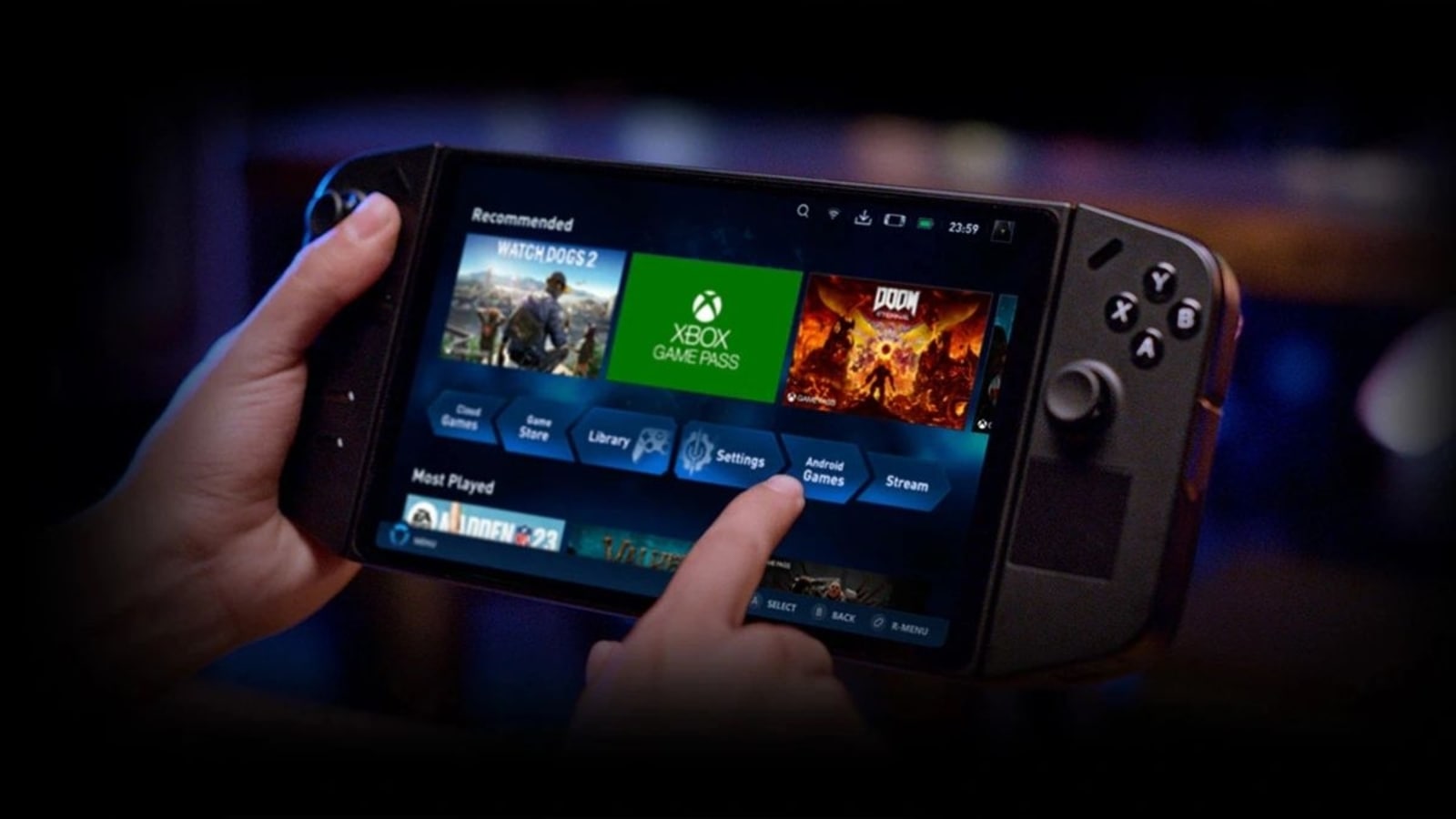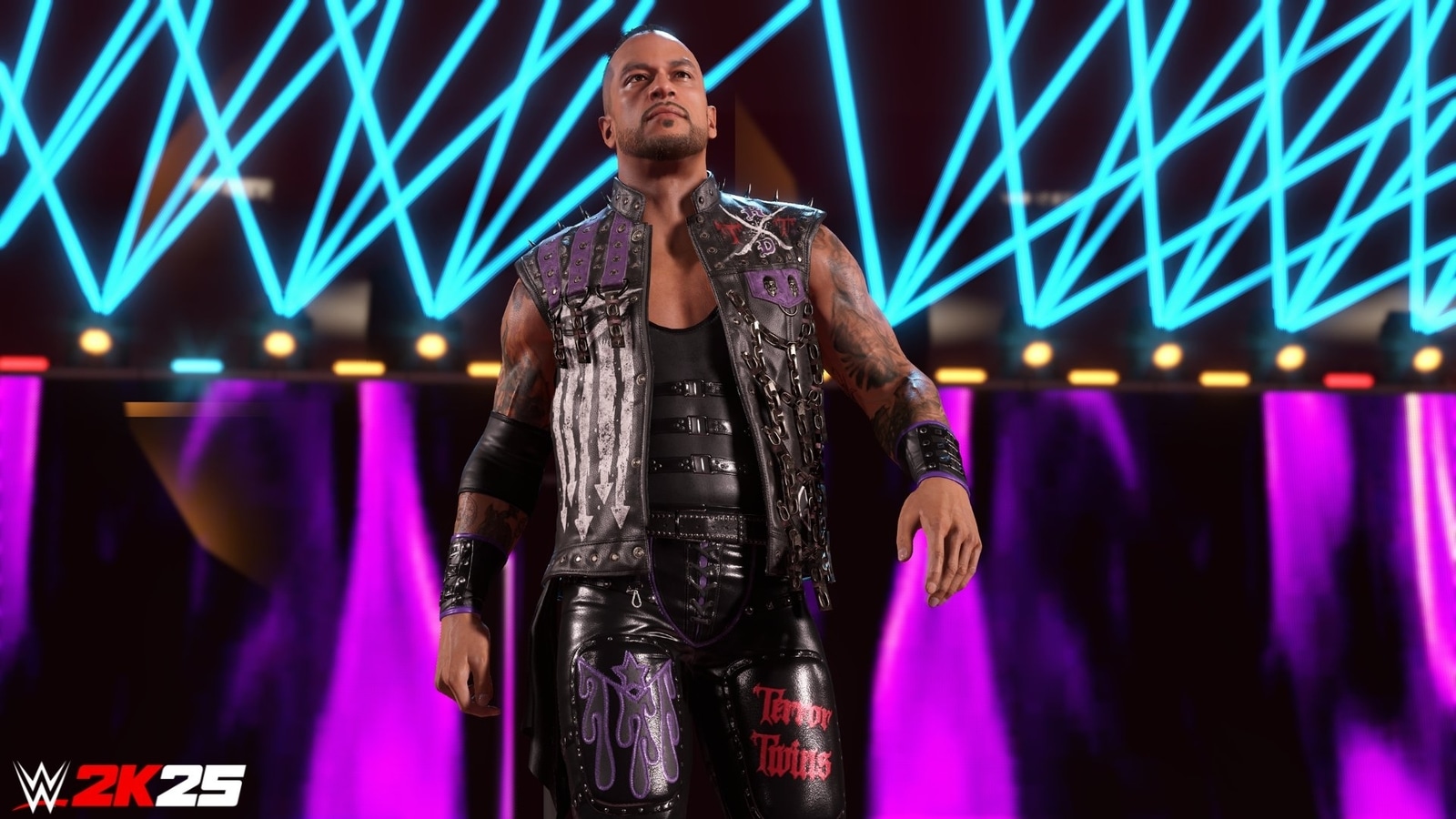Verdict
It’s hard to think of a better gateway to FPV flight than the DJI Avata 2 package. It includes everything you need to get started, is easy to set up and control, and is built to withstand the inevitable minor crashes you’ll suffer. It also supports more advanced flying with the optional twin-stick controller.
Pros
- Makes FPV flying easier than ever
- Lightweight Goggles 3 with pass-through video
- Good battery life
- Impressive camera performance
Cons
- Weight restricts legal UK flight locations
- Quite expensive
-
All-in-one FPV drone kitPackage contains drone, FPV headset and motion controller -
Improved image sensorLarger 1/1.3in sensor supports 10-bit D Log M and 4K/60fps video -
Bundled with one-handed controllerRC Motion 3 offers forgiving FPV control
Introduction
The DJI Avata 2 is an FPV (first-person view) drone designed to put the user in a virtual cockpit via a pair of goggles and a real-time camera feed.
Handling more like a plane than the relatively sedate and steady Mini, Air and Mavic camera drones that are DJI’s bread and butter, the Avata 2 can bank, roll and loop through the air, zip nimbly through tight gaps and plunge down steep cliffs before pulling up at the last second.
It’s an altogether more adrenaline-fuelled experience than a ‘normal’ drone, and the chances of crashing are higher, but as with the first Avata (released 2022), DJI has attempted to make things simple and safe enough that FPV novices can get going quickly. There are also a number of tweaks and improvements over the Avata – if not any significant change in price.
As a relative newcomer to FPV, can the DJI Avata 2 turn me into a gravity-spurning stunt pilot? Let’s find out.
Design
- 377g take-off weight
- Goggles 3 feature two 1080p OLED displays
- One-handed RC Motion 3 controller
The DJI Avata 2 is sleeker than its predecessor, with its camera integrated fully into the line of the body along with the four integrated rotor guards and removable battery. It’s about 40g lighter too, and DJI claims the reworked design improves aerial agility and responsiveness.
It comes with 46GB of built-in storage for videos and photos, plus a microSD slot for expansion and a USB-C for data transfer and battery charging.
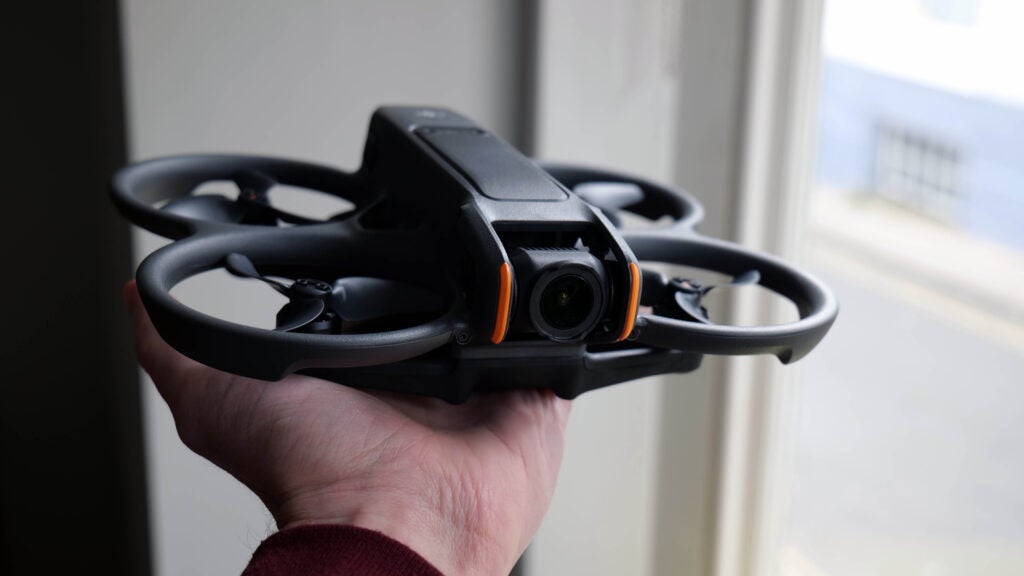
Note that, at about 380g, it’s too heavy to fall into the same desirable sub-250g weight class as DJI’s Mini range. In the UK, that means the Avata 2 can’t be flown over or closer than 50m to ‘uninvolved people’ (meaning anyone outside of the pilot and their companions), or flown within 150m of residential, recreational, commercial or industrial sites.
Good luck, then, finding somewhere you’re legally allowed to fly it. This isn’t the product’s fault, of course, but it’s something that does detract from its desirability in the UK. US and EU laws aren’t as strict, mind you – so if you live elsewhere it’s less of a big deal.
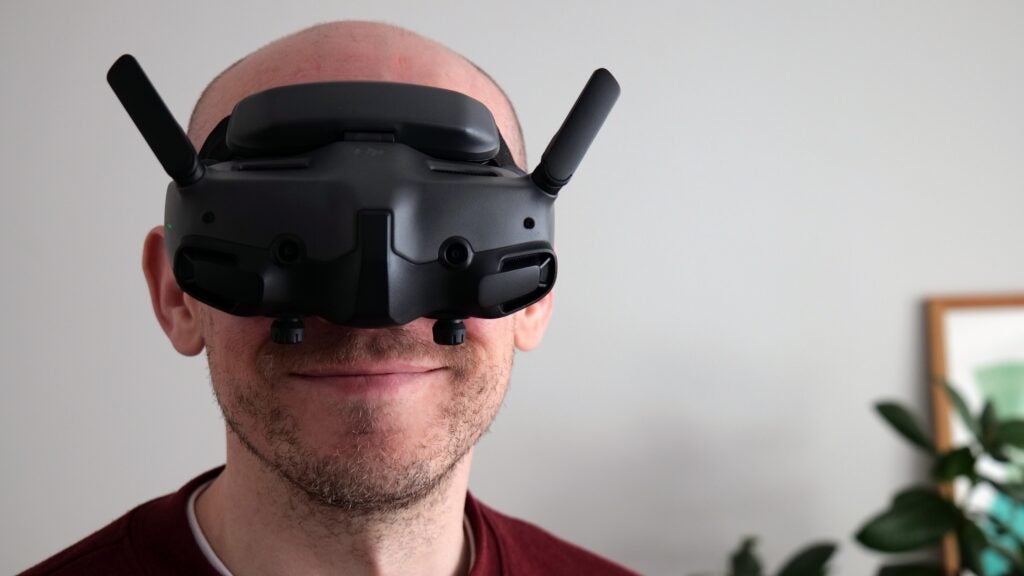
The drone is only one part of the package, however: it comes with the new DJI Goggles 3 headset and RC Motion 3 controller, both of which are refined versions of Avata accessories.
The Goggles 3 are excellent. Lightweight and comfortable to wear, with an easy-to-adjust strap and eyepieces, I was able to get a snug fit and adjust the dioptres to suit my myopic eyes in a matter of seconds. Inside the Goggles 3 are two 100Hz 1080p micro OLED displays, affording an ultra-low latency view from the Avata 2 drone’s camera.
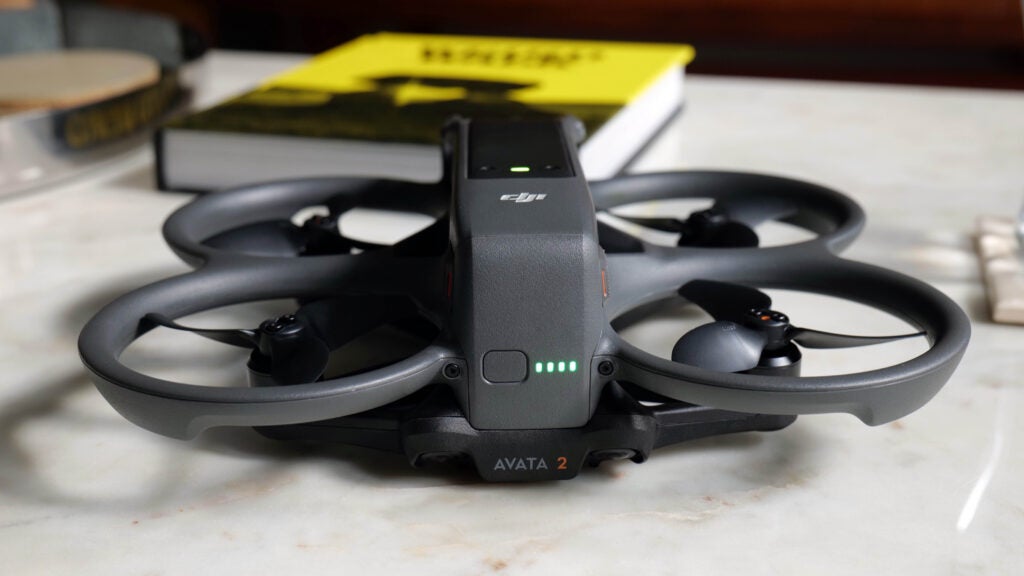
It also features its own cameras; with a double tap on the side of the headset you can switch to a live view of what your eyes would be seeing were you not wearing it. It’s much easier than taking the headset off every time you want to check out your surroundings.
A USB-C port recharges the Goggles 3’s built-in battery, as well as enabling you to connect to a phone or tablet so that your companions can watch a live feed of the drone’s cockpit viewpoint. It’s a welcome way to prevent the rest of your group from getting bored to death while you’re flying.
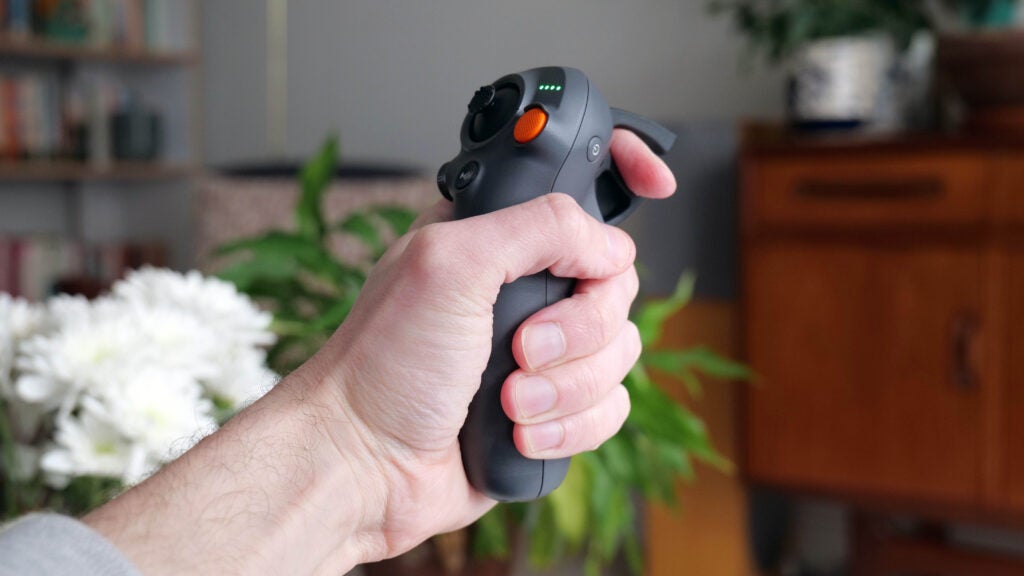
The RC Motion 3 is a single-handed motion controller with a few physical controls, like a two-stop trigger to adjust the throttle and large brake button to make the drone stop and hover in place if you’re panicking about a crash. It’s very light and compact, and comfortable to hold and use one-handed.
Flight performance
- Three flight modes to ease beginners in
- 23-minute battery life
- Manual mode requires Remote Controller 3
The DJI Avata 2 builds on its predecessor when it comes to flight performance, but it’s more gentle evolution than all-out revolution. A full battery can deliver a reasonable 23 minutes of flying time, which is similar to the original, and the speed seems to be around the same: 8m/s in Normal mode, 14m/s in Sport mode and a zippy 27m/s in Manual mode.
These flight modes are DJI’s way of slowly introducing new pilots to the demands of FPV flight, with Normal and Sport mode being something of a halfway house between ultra-safe ‘regular’ drones like the DJI Mavic range and the zero-handholding of Manual mode. In N and S modes, the drone’s lower speed and ability to hover in place makes crashes unlikely, even for novice pilots, while Manual removes the stabilisers, allowing for some risky but potentially breath-taking dives and turns.
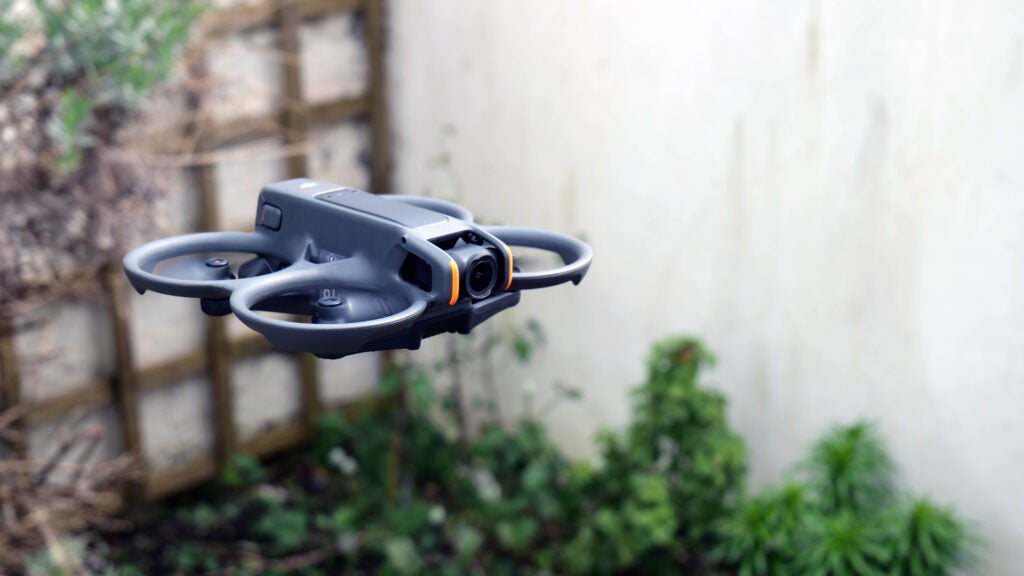
Note that to fly the DJI Avata 2 in full Manual mode, you’ll need the twin-stick Remote Controller 3 (£139/$199/€149), which doesn’t come in the standard Fly More bundles and needs to be purchased separately. Using the RC Motion 3 you’re essentially restricted to N and S modes – which as a newcomer eager not to pitch my review sample into the English Channel, I was happy to stick with for the most part.
I still managed to crash once, however, flying headlong into some railings while attempting to thread the Avata 2 through a gap – a move that’s surprisingly easy to pull off with the RC Motion 3. Having done so several times and high in confidence, I dinged the drone straight into a post – and upon recovering it, it was absolutely fine. Shout out to those propeller guards and the general build quality, and lesson learned for me.
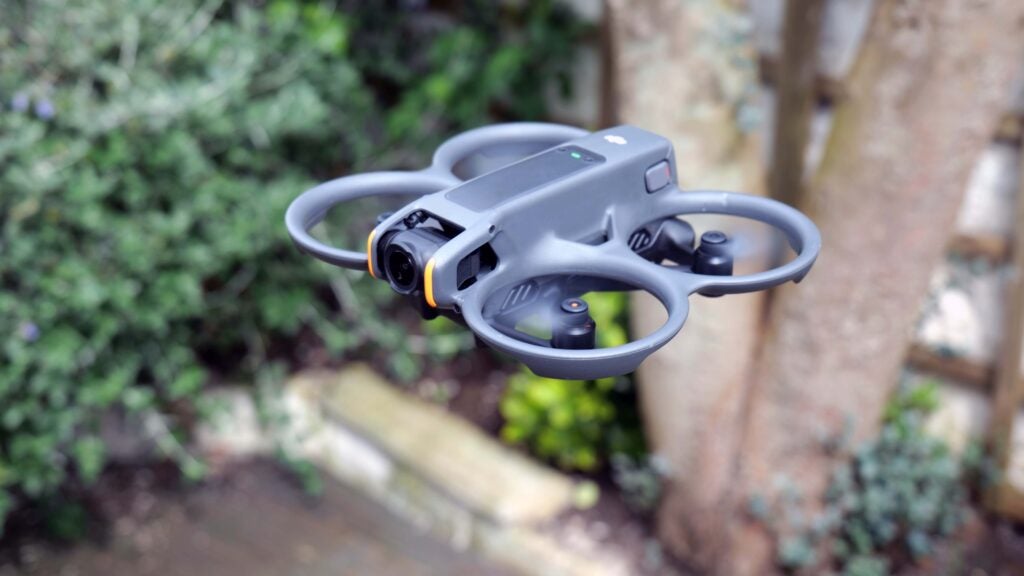
I think the RC Motion 3, which lets you control flight speed with trigger pressure and direction by tilting and rotating orientation, provides a sensible and forgiving halfway house between standard DJI drones and the demands of Manual mode.
It’s more difficult (if clearly not impossible) to crash, even if you may be a little disappointed that pulling off the sort of acrobatic dive moves you’ve seen on FPV pilots’ YouTube clips isn’t really possible. For those, you’ll need to graduate to Manual mode and buy the Remote Controller 3.
Camera performance
- 1/1.3-inch 12MP CMOS sensor
- Two modes of electronic image stabilisation
- 46GB of expandable internal storage
The DJI Avata 2 camera specs are slightly improved over those of the original Avata. While video resolutions and frame rates are largely the same (4K at up to 60fps, or 2.7K/1080p at up to 120fps), the larger sensor size means better low-light and wider dynamic range. This still isn’t a camera that excels in dark conditions, but it’ll draw a bit more detail out of interiors and night-time shots than its predecessor.
It can now also shoot video with a 10-bit D Log M colour profile. This alternative to the Standard mode looks flat and lifeless straight out of the camera, but offers up a lot more scope for colour grading and correction in post-production; video editors who know their hue from their chroma will be able achieve even better dynamic range and colour detail. Amateurs can stick to Standard, which looks absolutely acceptable to my eyes, but it’s great to have the option.
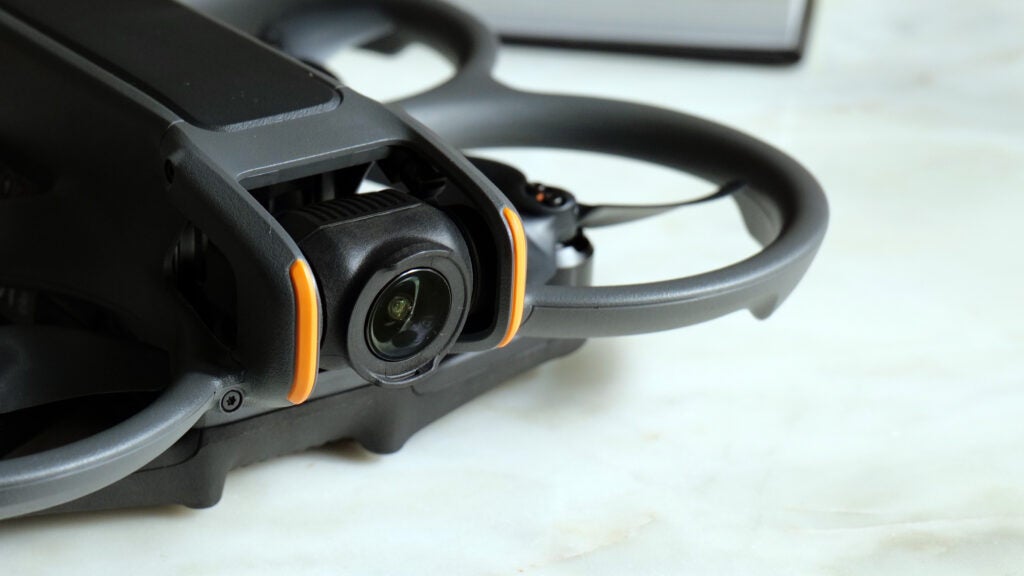
DJI’s HorizonSteady and RockSteady image stabilisation modes are available, and both quite effective. HorizonSteady endeavours to keep the horizon locked no matter how much the drone pitches, while RockSteady simply keeps everything smooth and stable. I preferred the look of the latter by far, but both have their place in the creative arsenal.
The camera has an ultra-wide angle field-of-view, much like a GoPro or similar action camera, and while this results in a fair bit of distortion around the edges, it feels like a sensible choice in that it captures more and provides a more dramatic view. You can crop videos in post to avoid the distortion or change the field-of-view in the camera settings if preferred.
Finally, there’s a generous 46GB of storage space built into the drone body, with a microSD slot enabling expansion should you need it. That’s more than double the internal space in the Avata, and enough for about 50 minutes of 4K/60fps video.
Latest deals
Should you buy it?
You should buy if you want a user-friendly entry point to FPV flying
With its easy setup, controls and general user-friendly approach, the DJI Avata 2 follows its predecessor in being an excellent FPV drone for new pilots. I can attest that it also survives crashes well.
You shouldn’t buy if you want a simple camera drone
If you just want to get in the air and take nice photos and videos, a more composed and safety-conscious drone such as the DJI Mini 4 Pro or Air 3 is recommended.
Final Thoughts
If you’ve viewed some of the incredible gravity-defying stunts performed by FPV drone pilots online and want a shortcut to pulling off the same, you might be disappointed by the DJI Avata 2’s softly-softly approach to FPV flight. The bundled motion-sensitive controller doesn’t suit this type of extreme flying; instead, it’s designed to gradually build up your confidence as an FPV pilot.
Even as a seasoned drone reviewer, I’m still a newbie when it comes to FPV, and I found the DJI Avata 2 (like the Avata before it) to be ideal for my level. My skills are limited, but with the RC Motion 3 I was able to fly through tiny gaps, skim low over the ground and make tight turns in Normal and Sport modes. I’m looking forward to using the twin-stick Remote Controller 3 to attempt Manual mode in the future, when I’m more comfortable – and I appreciate that the Avata 2 is more accommodating than most FPV drones in this regard.
While not an overwhelming improvement on the original to the point where those happy with their Avata should immediately ditch it for the new model, the DJI Avata 2 is a solid evolutionary step in the series and a great gateway into the world of FPV. Check out our Best Drones guide for even more options.
How we test
We thoroughly test every drone we review. We’ll always tell you what we find and we never, ever, accept money to review a product.
Flight safety features fully tested
Automated flight modes tested
FAQs
Yes, the DJI Avata 2 is designed as a gateway drone for first-person-view flying. However, there are easier drones to control if you just want to take photos and videos.
No, you’ll need to use the DJI Goggles 3 that comes bundled with the drone.
Verdict
It’s hard to think of a better gateway to FPV flight than the DJI Avata 2 package. It includes everything you need to get started, is easy to set up and control, and is built to withstand the inevitable minor crashes you’ll suffer. It also supports more advanced flying with the optional twin-stick controller.
Pros
- Makes FPV flying easier than ever
- Lightweight Goggles 3 with pass-through video
- Good battery life
- Impressive camera performance
Cons
- Weight restricts legal UK flight locations
- Quite expensive
-
All-in-one FPV drone kitPackage contains drone, FPV headset and motion controller -
Improved image sensorLarger 1/1.3in sensor supports 10-bit D Log M and 4K/60fps video -
Bundled with one-handed controllerRC Motion 3 offers forgiving FPV control
Introduction
The DJI Avata 2 is an FPV (first-person view) drone designed to put the user in a virtual cockpit via a pair of goggles and a real-time camera feed.
Handling more like a plane than the relatively sedate and steady Mini, Air and Mavic camera drones that are DJI’s bread and butter, the Avata 2 can bank, roll and loop through the air, zip nimbly through tight gaps and plunge down steep cliffs before pulling up at the last second.
It’s an altogether more adrenaline-fuelled experience than a ‘normal’ drone, and the chances of crashing are higher, but as with the first Avata (released 2022), DJI has attempted to make things simple and safe enough that FPV novices can get going quickly. There are also a number of tweaks and improvements over the Avata – if not any significant change in price.
As a relative newcomer to FPV, can the DJI Avata 2 turn me into a gravity-spurning stunt pilot? Let’s find out.
Design
- 377g take-off weight
- Goggles 3 feature two 1080p OLED displays
- One-handed RC Motion 3 controller
The DJI Avata 2 is sleeker than its predecessor, with its camera integrated fully into the line of the body along with the four integrated rotor guards and removable battery. It’s about 40g lighter too, and DJI claims the reworked design improves aerial agility and responsiveness.
It comes with 46GB of built-in storage for videos and photos, plus a microSD slot for expansion and a USB-C for data transfer and battery charging.

Note that, at about 380g, it’s too heavy to fall into the same desirable sub-250g weight class as DJI’s Mini range. In the UK, that means the Avata 2 can’t be flown over or closer than 50m to ‘uninvolved people’ (meaning anyone outside of the pilot and their companions), or flown within 150m of residential, recreational, commercial or industrial sites.
Good luck, then, finding somewhere you’re legally allowed to fly it. This isn’t the product’s fault, of course, but it’s something that does detract from its desirability in the UK. US and EU laws aren’t as strict, mind you – so if you live elsewhere it’s less of a big deal.

The drone is only one part of the package, however: it comes with the new DJI Goggles 3 headset and RC Motion 3 controller, both of which are refined versions of Avata accessories.
The Goggles 3 are excellent. Lightweight and comfortable to wear, with an easy-to-adjust strap and eyepieces, I was able to get a snug fit and adjust the dioptres to suit my myopic eyes in a matter of seconds. Inside the Goggles 3 are two 100Hz 1080p micro OLED displays, affording an ultra-low latency view from the Avata 2 drone’s camera.

It also features its own cameras; with a double tap on the side of the headset you can switch to a live view of what your eyes would be seeing were you not wearing it. It’s much easier than taking the headset off every time you want to check out your surroundings.
A USB-C port recharges the Goggles 3’s built-in battery, as well as enabling you to connect to a phone or tablet so that your companions can watch a live feed of the drone’s cockpit viewpoint. It’s a welcome way to prevent the rest of your group from getting bored to death while you’re flying.

The RC Motion 3 is a single-handed motion controller with a few physical controls, like a two-stop trigger to adjust the throttle and large brake button to make the drone stop and hover in place if you’re panicking about a crash. It’s very light and compact, and comfortable to hold and use one-handed.
Flight performance
- Three flight modes to ease beginners in
- 23-minute battery life
- Manual mode requires Remote Controller 3
The DJI Avata 2 builds on its predecessor when it comes to flight performance, but it’s more gentle evolution than all-out revolution. A full battery can deliver a reasonable 23 minutes of flying time, which is similar to the original, and the speed seems to be around the same: 8m/s in Normal mode, 14m/s in Sport mode and a zippy 27m/s in Manual mode.
These flight modes are DJI’s way of slowly introducing new pilots to the demands of FPV flight, with Normal and Sport mode being something of a halfway house between ultra-safe ‘regular’ drones like the DJI Mavic range and the zero-handholding of Manual mode. In N and S modes, the drone’s lower speed and ability to hover in place makes crashes unlikely, even for novice pilots, while Manual removes the stabilisers, allowing for some risky but potentially breath-taking dives and turns.

Note that to fly the DJI Avata 2 in full Manual mode, you’ll need the twin-stick Remote Controller 3 (£139/$199/€149), which doesn’t come in the standard Fly More bundles and needs to be purchased separately. Using the RC Motion 3 you’re essentially restricted to N and S modes – which as a newcomer eager not to pitch my review sample into the English Channel, I was happy to stick with for the most part.
I still managed to crash once, however, flying headlong into some railings while attempting to thread the Avata 2 through a gap – a move that’s surprisingly easy to pull off with the RC Motion 3. Having done so several times and high in confidence, I dinged the drone straight into a post – and upon recovering it, it was absolutely fine. Shout out to those propeller guards and the general build quality, and lesson learned for me.

I think the RC Motion 3, which lets you control flight speed with trigger pressure and direction by tilting and rotating orientation, provides a sensible and forgiving halfway house between standard DJI drones and the demands of Manual mode.
It’s more difficult (if clearly not impossible) to crash, even if you may be a little disappointed that pulling off the sort of acrobatic dive moves you’ve seen on FPV pilots’ YouTube clips isn’t really possible. For those, you’ll need to graduate to Manual mode and buy the Remote Controller 3.
Camera performance
- 1/1.3-inch 12MP CMOS sensor
- Two modes of electronic image stabilisation
- 46GB of expandable internal storage
The DJI Avata 2 camera specs are slightly improved over those of the original Avata. While video resolutions and frame rates are largely the same (4K at up to 60fps, or 2.7K/1080p at up to 120fps), the larger sensor size means better low-light and wider dynamic range. This still isn’t a camera that excels in dark conditions, but it’ll draw a bit more detail out of interiors and night-time shots than its predecessor.
It can now also shoot video with a 10-bit D Log M colour profile. This alternative to the Standard mode looks flat and lifeless straight out of the camera, but offers up a lot more scope for colour grading and correction in post-production; video editors who know their hue from their chroma will be able achieve even better dynamic range and colour detail. Amateurs can stick to Standard, which looks absolutely acceptable to my eyes, but it’s great to have the option.

DJI’s HorizonSteady and RockSteady image stabilisation modes are available, and both quite effective. HorizonSteady endeavours to keep the horizon locked no matter how much the drone pitches, while RockSteady simply keeps everything smooth and stable. I preferred the look of the latter by far, but both have their place in the creative arsenal.
The camera has an ultra-wide angle field-of-view, much like a GoPro or similar action camera, and while this results in a fair bit of distortion around the edges, it feels like a sensible choice in that it captures more and provides a more dramatic view. You can crop videos in post to avoid the distortion or change the field-of-view in the camera settings if preferred.
Finally, there’s a generous 46GB of storage space built into the drone body, with a microSD slot enabling expansion should you need it. That’s more than double the internal space in the Avata, and enough for about 50 minutes of 4K/60fps video.
Latest deals
Should you buy it?
You should buy if you want a user-friendly entry point to FPV flying
With its easy setup, controls and general user-friendly approach, the DJI Avata 2 follows its predecessor in being an excellent FPV drone for new pilots. I can attest that it also survives crashes well.
You shouldn’t buy if you want a simple camera drone
If you just want to get in the air and take nice photos and videos, a more composed and safety-conscious drone such as the DJI Mini 4 Pro or Air 3 is recommended.
Final Thoughts
If you’ve viewed some of the incredible gravity-defying stunts performed by FPV drone pilots online and want a shortcut to pulling off the same, you might be disappointed by the DJI Avata 2’s softly-softly approach to FPV flight. The bundled motion-sensitive controller doesn’t suit this type of extreme flying; instead, it’s designed to gradually build up your confidence as an FPV pilot.
Even as a seasoned drone reviewer, I’m still a newbie when it comes to FPV, and I found the DJI Avata 2 (like the Avata before it) to be ideal for my level. My skills are limited, but with the RC Motion 3 I was able to fly through tiny gaps, skim low over the ground and make tight turns in Normal and Sport modes. I’m looking forward to using the twin-stick Remote Controller 3 to attempt Manual mode in the future, when I’m more comfortable – and I appreciate that the Avata 2 is more accommodating than most FPV drones in this regard.
While not an overwhelming improvement on the original to the point where those happy with their Avata should immediately ditch it for the new model, the DJI Avata 2 is a solid evolutionary step in the series and a great gateway into the world of FPV. Check out our Best Drones guide for even more options.
How we test
We thoroughly test every drone we review. We’ll always tell you what we find and we never, ever, accept money to review a product.
Flight safety features fully tested
Automated flight modes tested
FAQs
Yes, the DJI Avata 2 is designed as a gateway drone for first-person-view flying. However, there are easier drones to control if you just want to take photos and videos.
No, you’ll need to use the DJI Goggles 3 that comes bundled with the drone.

